Have you ever wondered why your cat loves to sniff you? It turns out that there’s more to this behavior than meets the eye. Cats have an incredible sense of smell, with an estimated 200 million scent receptors in their noses. This heightened sense of smell allows them to explore their surroundings, gather information, and communicate in ways we humans can’t fully comprehend.
In this article, we’ll dive deeper into the fascinating world of cat sniffing behavior. We’ll explore the remarkable sense of smell in cats, their unique nasal anatomy, and the reasons behind their sniffing habits. By gaining a better understanding of why our feline friends engage in this behavior, we can strengthen our bond with them and provide the care they need.
Key Takeaways:
- Cats have an incredible sense of smell, with 200 million scent receptors.
- Sniffing behavior helps cats gather information about their environment and other animals.
- Cat sniffing is a form of communication and can be a sign of affection or territorial marking.
- Understanding cat sniffing behavior can strengthen the bond between cats and their owners.
- Excessive sniffing may indicate stress or anxiety in cats, and veterinary advice should be sought.
The Remarkable Sense of Smell in Cats
Cats have an extraordinary sense of smell that far surpasses our own. With 200 million scent receptors in their noses, compared to our mere 5 million, they have a remarkable olfactory sense. This heightened sense of smell allows cats to detect odors that are undetectable to humans, and it plays a crucial role in their daily lives.
Cats can categorize and identify different smells, which helps them make sense of their environment and navigate it confidently. They can detect even the faintest of odors, such as the presence of potential prey. Their acute sense of smell also allows them to explore the world around them, gather information, and even communicate with other cats using scent markers.
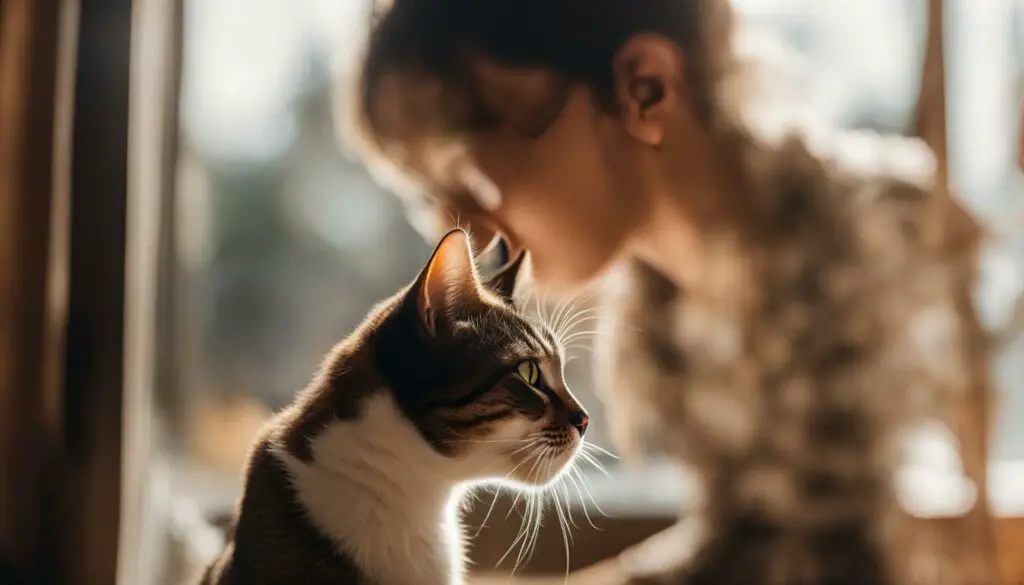
A cat’s sense of smell is so powerful because of their unique nasal structure. They have special patterns called nasal planums, comparable to human fingerprints, which increase the surface area available for detecting odors. A cat’s moist nose helps scent particles stick to it more effectively, aiding in scent detection. Additionally, cats have a specialized organ in their mouths called the vomeronasal organ, also known as the Jacobson’s organ, which allows them to detect pheromones and play a vital role in their communication and social interactions.
The Fascinating World of Cat’s Noses
Cats have an extraordinary sense of smell, and their noses play a crucial role in their daily lives. A cat’s nose is not only a remarkable sensory organ but also a tool for communication and information gathering. Understanding the fascinating features of a cat’s nose can give us insights into their scent recognition and perception.
One unique aspect of a cat’s nose is the presence of scent glands. These specialized glands are located in different parts of their nose and are responsible for producing and releasing pheromones. The scent glands help cats mark their territory and communicate with other felines. They play a vital role in establishing social hierarchies and conveying information about their reproductive status.
The moistness of a cat’s nose is another intriguing characteristic. The dampness helps scent particles stick to the nose’s surface, enhancing their ability to detect and identify different smells. The moisture also aids in the proper functioning of the vomeronasal organ, also known as the Jacobson’s organ. This sensory organ is capable of detecting pheromones and plays a significant role in a cat’s communication and social interactions.
| Scent Glands | Location | Function |
|---|---|---|
| Cheek glands | Located on the sides of the face | Used for marking territory and social bonding |
| Perineal glands | Located near the anal opening | Used for scent marking and sexual communication |
| Paw pads glands | Located on the bottom of the paws | Leave scent trails while walking and scratching |
In summary, a cat’s nose is a multifunctional and intricate organ that plays a vital role in their behavior and communication. The scent glands and their secretions help cats mark their territory, attract mates, and establish social bonds. The unique features of a cat’s nose, such as the moistness and the vomeronasal organ, enhance their sense of smell and allow them to perceive the world in a way that is beyond our comprehension.
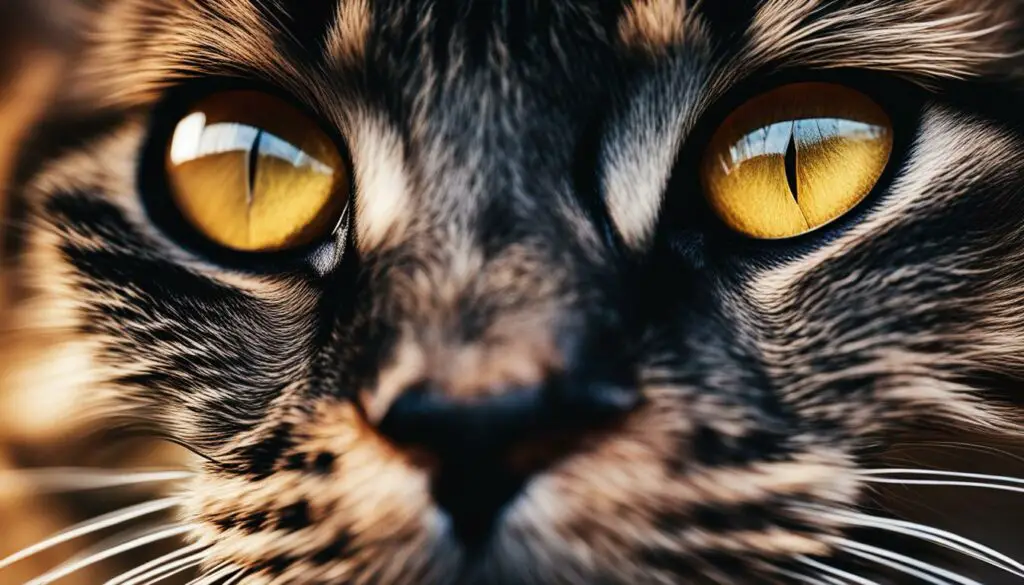
Exploring the Reasons Behind Sniffing Behavior
When it comes to understanding why cats engage in sniffing behavior, there are several key factors to consider. One of the primary reasons is their innate investigative behavior. Cats are naturally curious creatures, and sniffing allows them to gather information about their surroundings and explore their environment. This behavior satisfies their curiosity and helps them navigate the world around them.
Another reason behind sniffing behavior in cats is territorial marking. Cats have scent glands located on various parts of their bodies, including their cheeks, paws, and tail. When they sniff objects or even their owners, they leave behind their scent as a way to mark their territory. This territorial marking behavior is a way for cats to assert ownership and communicate their presence to other animals.
Cat scent marking is also influenced by their natural instincts. Cats have a strong sense of smell that allows them to detect subtle changes in the environment. By sniffing, they can detect pheromones left by other cats or potential prey. This behavior helps them gather information about their surroundings and identify potential threats or opportunities. It is a vital part of their survival instincts and plays a role in their hunting rituals as well as social interactions.
| Investigative Behavior | Territorial Marking | Cat Scent Marking |
|---|---|---|
| Driven by curiosity and the desire to explore their environment | Scent glands allow cats to mark their territory | Scent marking is a form of communication and plays a role in social interactions |
| Helps cats gather information about their surroundings | Asserts ownership and communicates their presence to other animals | Allows cats to detect pheromones and identify potential threats or opportunities |
| Satisfies their natural instincts and curiosity | Provides a sense of security and familiarity in their environment | Plays a role in hunting rituals and courtship behaviors |
Understanding the reasons behind sniffing behavior in cats is crucial for pet owners. It allows us to interpret their actions correctly and provide the appropriate care and attention. By acknowledging and respecting their investigative behavior and territorial instincts, we can create a nurturing environment that meets their needs.
Understanding Scent Marking in Cats
Cats have a remarkable and intricate system of scent glands that they use for communication and territorial behavior. These scent glands, located in various parts of their body, produce pheromones that convey important messages to other cats. By understanding how cats use scent marking, pet owners can gain valuable insight into their cat’s behavior and strengthen their bond.
The Types of Scent Glands in Cats
Cats have several types of scent glands that they use for scent marking. These include:
- Cheek glands: Located on the sides of a cat’s face, these glands are used to mark objects and individuals with their unique scent.
- Preputial glands: Found in both male and female cats, these glands are located on the genitals and play a role in sexual communication and attraction.
- Anal glands: Situated near a cat’s anus, these glands produce a distinct scent that is used for territorial marking and identification.
- Paw pads: Cats have scent glands on their paw pads, which they use to mark their territory as they walk or scratch on objects.
Scent-based Communication and Territory
When a cat engages in scent marking, they are communicating important information to other cats. By leaving their unique scent on objects or surfaces, cats establish their territory and communicate their presence. This can help prevent conflicts with other cats and create a sense of security in their environment. Scent marking is particularly common in multi-cat households, where cats may use scent to establish dominance and hierarchical order.
Understanding and respecting a cat’s scent marking behavior can help pet owners create a comfortable and stress-free environment for their feline companions. Providing appropriate scratching posts, litter boxes, and vertical spaces can help cats satisfy their marking instincts in a positive and acceptable way.
| Scent Gland | Location | Function |
|---|---|---|
| Cheek glands | Sides of the face | Marking objects and individuals |
| Preputial glands | Genitals | Sexual communication and attraction |
| Anal glands | Near the anus | Territorial marking and identification |
| Paw pads | Paws | Marking territory through walking and scratching |
The Power of Artificial Pheromones for Cats
Understanding pet behavior and finding effective solutions to address various issues is essential for cat owners. One of the remarkable discoveries in feline social behavior is the power of artificial pheromones. These synthetic pheromones replicate the natural ones that cats release when they feel safe and secure, providing a calming effect on their well-being. Artificial pheromones have proven to be valuable tools in managing stress and anxiety in cats, promoting a harmonious environment for both the pet and the owner.
Artificial pheromones come in different forms, such as sprays, diffusers, or collars, making it convenient for pet owners to incorporate them into their cat’s daily routine. By diffusing the pheromones in the home, pet owners create an atmosphere of reassurance and relaxation. The pheromones help reduce stress levels, ease anxiety, and provide a sense of familiarity and comfort to cats, especially during challenging situations like moving to a new home or introducing a new pet into the household.
Introducing artificial pheromones into a cat’s environment can have numerous benefits. It can aid in preventing inappropriate behaviors caused by stress, such as urine spraying, scratching furniture, or excessive grooming. Furthermore, artificial pheromones can enhance the bond between pet and owner by creating a positive association with their environment and reducing anxiety triggers. It is crucial for pet owners to consult with a veterinarian to determine the most appropriate type and application method of artificial pheromones for their feline companion.
| Benefits of Artificial Pheromones for Cats |
|---|
| Reduces stress and anxiety |
| Helps prevent inappropriate behaviors |
| Enhances the bond between pet and owner |
| Promotes a sense of security and familiarity |
Investing in the power of artificial pheromones can significantly improve the overall well-being of cats and enhance the pet-owner relationship. By creating a harmonious and stress-free environment through the use of these synthetic pheromones, cat owners can provide their feline companions with the care and attention they deserve.
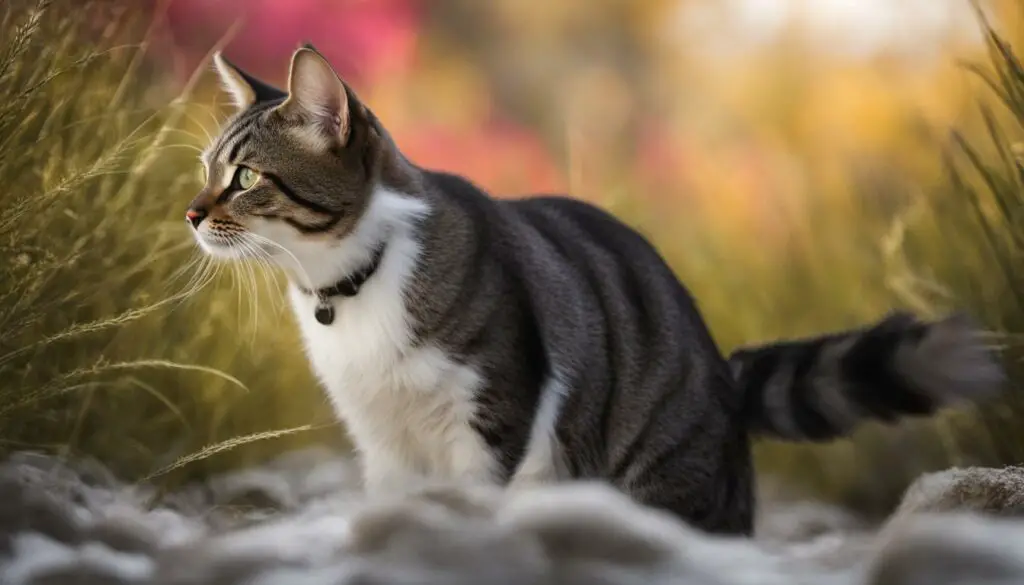
Exploring the Meaning Behind Sniffing Behavior
Sniffing behavior in cats serves various purposes and is a natural part of their socialization and investigation process. When cats sniff their owners, it is a way for them to gather information about their environment and establish a deeper connection with their humans. Sniffing is a form of communication that allows cats to explore their surroundings, mark their territory, and satisfy their natural hunting instincts. It is a behavior that should be understood and interpreted in the context of a cat’s natural instincts and social behaviors.
Cat socialization plays a significant role in understanding their sniffing behavior. Just like humans, cats use their sense of smell to connect with others, and sniffing their owners is a way for them to strengthen the bond between human and feline. By sniffing, cats can identify the scent of their owner, which helps them feel safe and secure in their presence. It is their way of recognizing and acknowledging their human companion.
Feline investigation is another reason behind sniffing behavior. Cats are naturally curious creatures, and sniffing allows them to explore and understand their environment. Through their sense of smell, they can detect scents that are undetectable to humans, helping them gain a deeper understanding of their surroundings, other animals, and potential threats. Sniffing also helps cats gather information about other cats, enabling them to communicate and establish social hierarchies.
| Cat Socialization | Feline Investigation |
|---|---|
| Cats sniff their owners to strengthen the bond and feel secure in their presence. | Sniffing allows cats to explore their environment, detect scents, and gather information. |
| It is a form of communication and recognition between cats and humans. | Sniffing helps cats understand their surroundings, other animals, and potential threats. |
| Cat socialization plays a significant role in sniffing behavior. | Cats are naturally curious and use their sense of smell to investigate their environment. |
Decoding the Reasons for Sniffing Everything
When cats engage in sniffing behavior, they are utilizing their remarkable sense of smell to gather information about their environment, other animals, and even their owners. Scent detection is a vital aspect of a cat’s investigative behavior, allowing them to create a mental map of their surroundings and feel more secure in their territory. By decoding the reasons behind their sniffing habits, we can gain insight into the complex feline world and strengthen the pet-human bond.

Cats have an extraordinary sense of smell, with 200 million scent receptors compared to our mere 5 million. They can distinguish between different smells and detect odors that are undetectable to humans. Their sniffing behavior serves as a way for them to categorize scents, locate potential prey, mark territory, and communicate with their owners. By understanding their heightened olfactory senses, we can appreciate the world through their perspective.
Sniffing everything is a natural instinct for cats, satisfying their curiosity and fulfilling their hunting instincts. It helps them gather information about their surroundings and the people in their lives. As pet owners, we can encourage investigative behavior by providing mental and physical stimulation, such as puzzle toys or interactive play sessions. This not only keeps our feline friends engaged but also strengthens the bond between us.
Understanding the Flehmen Response
The Flehmen response is a fascinating behavior exhibited by cats when they open their mouths slightly and lift their upper lip. This behavior is closely associated with sniffing and plays a significant role in their communication and scent analysis. It allows cats to gather more detailed sensory information using their vomeronasal organ, also known as the Jacobson’s organ.
The cat’s vomeronasal organ is located in the roof of their mouth and is responsible for processing and analyzing pheromones and other scents. By curling their lip and exposing the organ to the air, cats can bring more scent particles into contact with it, enhancing their ability to detect and interpret different smells.
The Flehmen response is most commonly observed when cats encounter unfamiliar scents or when they are trying to gather more information about a specific scent. It is believed to help them assess the potential threat or reproductive status of a particular individual or object. By engaging in the Flehmen response, cats can gain a more in-depth understanding of their surroundings and the other animals in their environment.
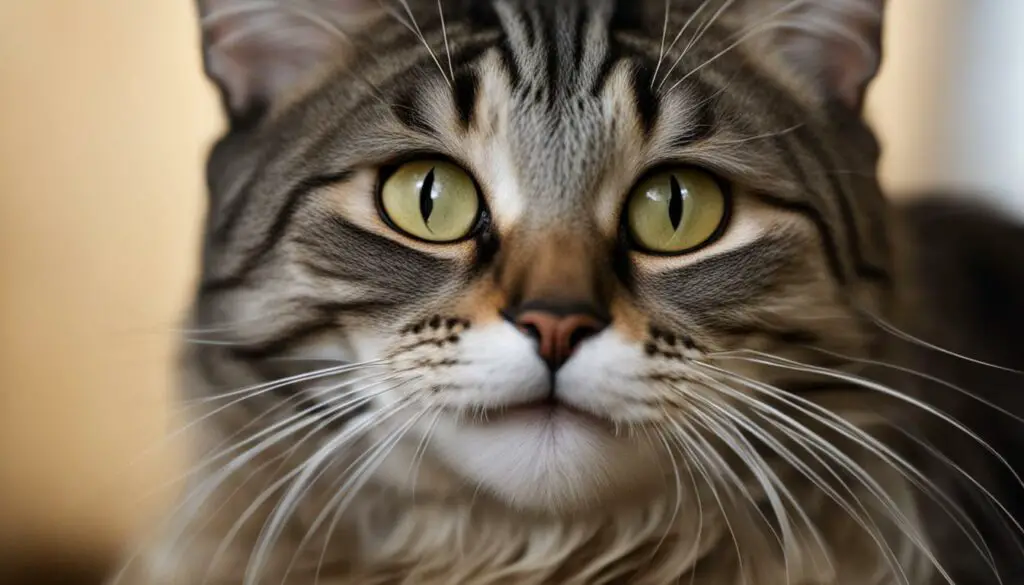
In summary, the Flehmen response is a unique behavior exhibited by cats during sniffing. It allows them to gather more detailed sensory information using their vomeronasal organ, aiding in scent analysis and communication. Understanding this behavior can provide valuable insights into a cat’s perception of their environment and their interactions with other animals.
Unraveling the Mystery of Sniff and Walk Away Behavior
Sniff and walk away behavior in cats can sometimes leave pet owners puzzled. Cats have unique sensory processing abilities that drive their sniffing behavior, and understanding the underlying psychology can shed light on why they exhibit this intriguing behavior.
When cats sniff their owners and then walk away, it could be due to a combination of factors. Firstly, cats have a highly developed sense of smell, and they use this sense to gather information about their environment, including their owners. Sniffing their owners allows them to familiarize themselves with their scent, which in turn helps them feel more secure and recognized in their territory. After sniffing, cats might feel satisfied with the information they’ve gathered and choose to move on to other activities.
Another reason for this behavior could be that cats are naturally independent animals who value their personal space. After sniffing their owners, they may simply be seeking some alone time. Just like humans, cats need moments of solitude to recharge and relax. It’s important to respect their boundaries and give them the space they need when they exhibit this behavior.
In conclusion, the sniff and walk away behavior in cats is a combination of their sensory processing abilities, their need for territorial recognition, and their desire for personal space. By understanding and honoring these aspects of feline behavior, pet owners can foster a healthy and fulfilling relationship with their feline companions, built on trust and mutual respect.
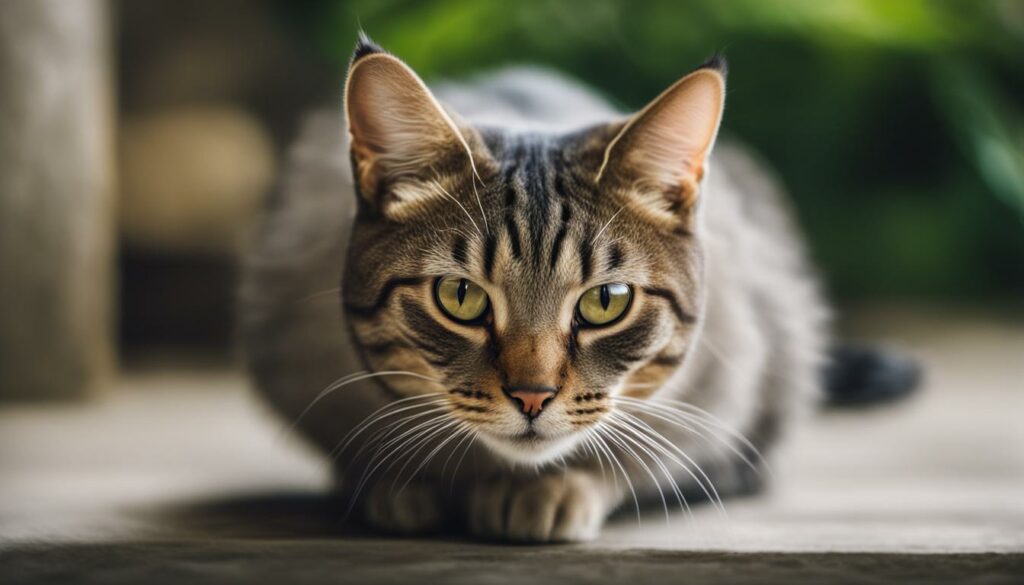
Table: Common Reasons for Sniff and Walk Away Behavior in Cats
| Reasons | Description |
|---|---|
| Information Gathering | Cats use their sense of smell to gather information about their environment, including their owners. Sniffing helps them recognize and feel secure in their territory. |
| Need for Personal Space | Cats are independent animals who value their personal space. After sniffing, they may simply be seeking some alone time. |
Cats as Masters of Scent Detection
Cats possess an extraordinary ability when it comes to scent analysis and smell recognition. Their keen sense of smell, combined with their natural instincts, allows them to navigate their surroundings and gather vital information about their environment. This remarkable olfactory prowess is a testament to their innate animal instincts.
Through their scent detection abilities, cats can pick up on changes in their environment that may go unnoticed by humans. They can identify and categorize different smells, allowing them to gather valuable information about their surroundings and the people around them. Whether it’s detecting pheromones, sensing emotional states, or recognizing familiar scents, cats excel in analyzing odors to make sense of the world around them.
“A cat’s sense of smell is a powerful tool that helps them navigate their world and communicate with other animals,” says Dr. Emily Johnson, a veterinarian specializing in feline behavior. “Their acute sense of smell allows them to establish territory, locate potential prey, and even detect changes in their owner’s emotional state.”
It’s fascinating to observe how cats utilize their sense of smell as a means of communication and exploration. Whether they are sniffing their owners, investigating their environment, or marking territory through scent, cats rely heavily on their olfactory senses to navigate and interact with the world around them.
Table: Comparing Scent Detection Abilities
| Cat | Human |
|---|---|
| 200 million scent receptors | 5 million scent receptors |
| Ability to detect pheromones and emotional states | Limited ability to detect pheromones |
| Can differentiate between various smells | Relatively limited smell recognition |
Cats truly are masters of scent detection. Their exceptional olfactory abilities allow them to gather information, communicate, and navigate their surroundings with incredible precision. By appreciating and understanding the power of their sense of smell, we can deepen our bond with our feline companions and provide them with a fulfilling and enriching environment.
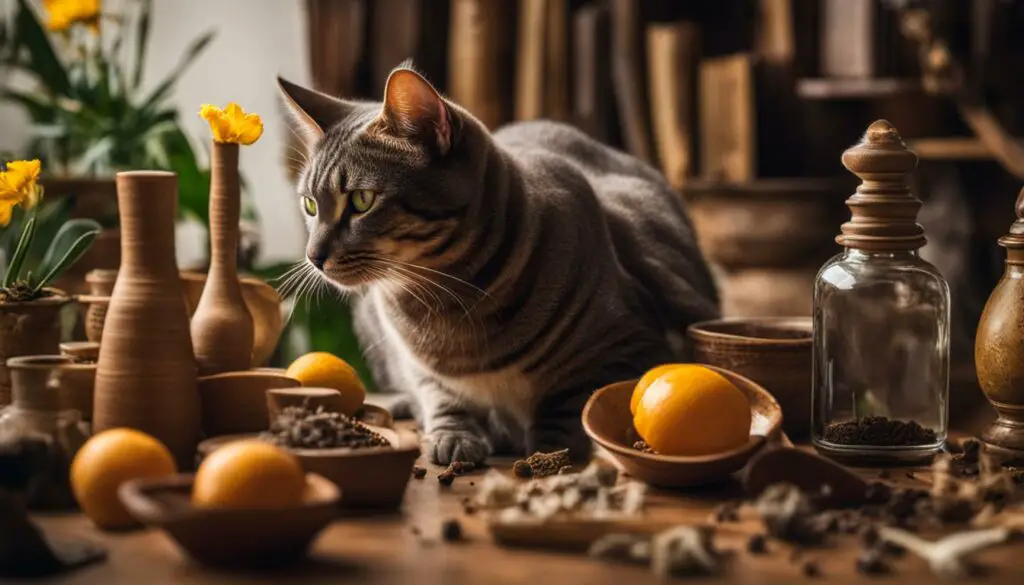
Providing Attention and Care to Your Cat
When it comes to our furry friends, pet companionship goes beyond providing food and shelter. It’s about building a strong bond and nurturing a relationship based on trust and understanding. Investing time and effort in your cat’s care can lead to a deeper level of human-animal bonding and enhance their overall well-being.
One crucial aspect of cat socialization is respecting their boundaries. Just like humans, cats need their alone time too. It’s important to create a safe and comfortable space where they can retreat when they need some peace and solitude. Provide a cozy bed or private area where they can relax undisturbed, ensuring they feel secure and valued.
Physical and mental stimulation are vital for a cat’s happiness and overall health. Engage in interactive play sessions to satisfy their natural instincts and provide mental enrichment. Interactive toys, such as puzzle feeders or scratching posts, can also keep them mentally stimulated and prevent boredom. Additionally, regularly grooming and cuddling your cat can help strengthen the bond between you and provide them with the affection they crave.
Creating a Cat-Friendly Environment
- Ensure your home is a safe and stimulating environment for your cat. Remove any hazardous items, secure windows and balconies, and provide scratching posts and climbing areas to satisfy their natural behaviors.
- Establish a consistent routine for feeding, playtime, and litter box maintenance. Cats thrive on predictability, and a structured routine can help reduce stress and anxiety.
- Consider using synthetic pheromones, such as sprays or diffusers, to create a calming atmosphere. These artificial pheromones can help alleviate stress and anxiety in cats, promoting a sense of well-being.
Remember, each cat is unique, and it’s essential to observe their behavior and listen to their cues. Building a strong bond with your cat requires patience, understanding, and a genuine love for these amazing creatures. With the right attention and care, you can provide a nurturing environment that promotes their overall happiness and strengthens the bond between you and your feline friend.
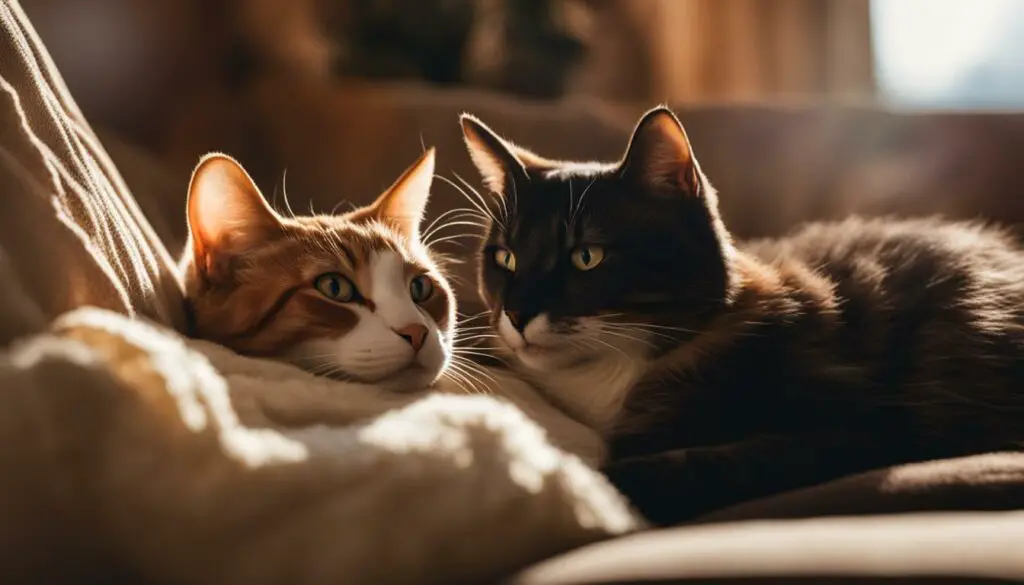
Signs of Stress or Anxiety in Cats
As pet owners, it’s important for us to be aware of the signs that may indicate stress or anxiety in our cats. While cats may exhibit different behaviors when they are feeling stressed, excessive sniffing can be one of the noticeable signs. This behavior can be an indicator that your feline friend is feeling anxious or overwhelmed.
Aside from excessive sniffing, other symptoms of stress or anxiety in cats may include changes in appetite, increased vocalization, hiding, or aggression. If you notice any of these signs, it’s essential to observe your cat’s overall behavior and look for any patterns or triggers that may be causing their distress.
It’s important to remember that cats can be sensitive creatures, and they may become anxious due to various factors such as changes in their environment, new additions to the household, or even disruptions in their daily routines. If you suspect that your cat is experiencing stress or anxiety, it’s advisable to seek veterinary advice to ensure their well-being and provide appropriate interventions.
By being attentive to our cats’ behaviors and providing a safe and supportive environment, we can help alleviate their stress and anxiety, promoting their overall health and happiness. Understanding the signs of stress and anxiety in our feline companions allows us to take proactive measures to address their needs and ensure a harmonious bond between us and our beloved pets.
Understanding the Bond Between Cats and Owners
The bond between cats and their owners is truly special. As a cat owner myself, I have experienced firsthand the unique connection that can develop between a feline friend and their human companion. Cats have a way of making us feel loved, understood, and cherished, and their sniffing behavior plays a significant role in strengthening this bond.
When a cat sniffs its owner, it is not just a simple act of curiosity. It is a social bonding cue, a way for cats to communicate and show affection. By sniffing us, cats are collecting information about our scent, our emotions, and our overall well-being. It’s their way of getting to know us on a deeper level, and it’s a sign that they trust and feel comfortable with us.
As pet owners, we can nurture this bond by responding positively to our cats’ sniffing behavior. We can reciprocate their affection by gently petting them and showing them love and attention. This reinforces the trust and connection between us, and it helps create a loving and harmonious relationship.
Social interaction and feline communication
Cat-human connection is not just limited to sniffing. Cats have a rich repertoire of communication cues that they use to interact with their owners. From purring and rubbing against us to meowing and kneading, each behavior serves a purpose and carries a message. By paying attention to these cues and understanding their meaning, we can deepen our bond with our cats and provide them with the love and care they need.
| Behavior | Meaning |
|---|---|
| Purring | Contentment, relaxation, and happiness |
| Rubbing against us | Marking territory and showing affection |
| Meowing | Seeking attention, hunger, or communication |
| Kneading | Sign of comfort and relaxation |
Creating a strong and loving bond
Building a strong bond with our cats requires patience, understanding, and a willingness to meet their needs. By providing them with a safe and stimulating environment, regular playtime, and quality time together, we can foster a deep and lasting connection. Remember, each cat is unique, and it’s important to respect their individual personalities and preferences.
So the next time your cat comes over to sniff you, embrace this moment of connection and cherish the bond you share. It’s a beautiful reminder of the love and trust that exists between cats and their owners.
Conclusion
Understanding cat behavior and feline communication is crucial for pet owners to provide the best care for their furry friends. Sniffing behavior plays a significant role in a cat’s daily interactions and is driven by their exceptional sense of smell and natural instincts.
Cats use their sense of smell to explore their environment, gather information about other animals, mark their territory, and communicate with their owners. Sniffing behavior helps them feel more secure, satisfies their hunting instincts, and strengthens the bond between cats and their owners.
By recognizing the motivations behind sniffing behavior, pet owners can better interpret their cat’s actions and provide the appropriate care and attention. Respecting their boundaries and providing mental and physical stimulation are essential to keeping cats happy and healthy.
| Section | SEO Keywords |
|---|---|
| Cat Behavior | cat behavior, pet behavior analysis, feline curiosity |
| Feline Communication | cat behavior, feline communication |
In Summary
In understanding our feline friends, it becomes clear that sniffing behavior is an intricate part of their nature. Cats use their exceptional sense of smell to explore their surroundings, gather information, communicate, and establish their territory. By delving into the reasons behind their sniffing habits, we can provide a nurturing and enriching environment for our furry companions.
As pet owners, recognizing the motivations behind our cats’ sniffing behavior is crucial. It allows us to interpret their actions correctly and provide the appropriate care and attention. By respecting their boundaries, allowing alone time when needed, and providing mental and physical stimulation, we can help our cats lead happy and healthy lives.
Sniffing behavior is not just about curiosity; it is a means for cats to communicate with us and strengthen the bond between human and feline. By responding appropriately to their sniffing habits, we can further cultivate the trust, affection, and understanding that form the foundation of our relationship with our beloved cats.
In conclusion, a cat’s sniffing behavior is a fascinating aspect of their behavior. Their acute sense of smell, coupled with their natural instincts and feline curiosity, drives them to explore and gather information about their environment. By appreciating and fostering this behavior, we can enhance our understanding of our cats and provide them with the love and care they deserve.
FAQ
Why do cats have such a strong sense of smell?
Cats have a keen sense of smell, with an estimated 200 million scent receptors in their noses. This heightened sense of smell allows them to explore their surroundings and gather information about the environment, other animals, and even their owners.
How do cats use their sense of smell?
Cats use their sense of smell to categorize and identify different smells, helping them make sense of their environment and navigate it confidently. They can also detect even the faintest of odors, like the presence of potential prey.
What is the vomeronasal organ in cats?
The vomeronasal organ, also known as the Jacobson’s organ, allows cats to detect pheromones and plays a vital role in their communication and social interactions.
Why do cats engage in excessive sniffing?
Cats engage in excessive sniffing behavior for various reasons, including natural curiosity, desire to explore their surroundings, hunting instincts, territorial marking, and courtship and mating rituals.
What is scent marking in cats?
Scent marking is a crucial aspect of feline communication. Cats use their scent glands to mark objects, surfaces, and even their owners to claim ownership and communicate important information to other cats.
How can artificial pheromones help reduce stress in cats?
Artificial pheromones, available in the form of sprays, diffusers, or collars, can be used to create a calming atmosphere and reduce a cat’s stress levels. These synthetic pheromones mimic the natural feline pheromones that cats release when they feel safe and secure.
Why do cats sniff everything around them?
Cats sniff everything to gather information about their environment, other animals, and their owners. It helps them create a mental map of their surroundings, feel more secure, and satisfy their natural instincts.
What is the Flehmen response in cats?
The Flehmen response, where a cat opens its mouth slightly and lifts its upper lip, is a behavior associated with sniffing. It allows cats to get a more in-depth analysis of scents using their vomeronasal organ.
Why do cats sniff their owners and walk away?
Cats may sniff their owners and then walk away due to distractions, their need for alone time, or simply to maintain their personal space. Respecting their boundaries is important for a healthy relationship.
How does a cat’s sense of smell contribute to their communication with humans?
Cats have highly developed scent detection abilities, allowing them to pick up on changes in their environment, detect pheromones, and sense emotional states in their owners. Their sense of smell plays a role in their communication and the bond between cats and humans.
What should I do if my cat exhibits excessive sniffing behavior?
Excessive sniffing behavior may be a sign of stress or anxiety in cats. It’s important to observe your cat’s overall behavior, look for any signs of distress, and seek veterinary advice if necessary.
How can I strengthen the bond between my cat and myself?
The bond between cats and owners is built on trust, affection, and understanding. By recognizing and responding appropriately to their sniffing habits, providing the right attention and care, you can strengthen the bond between you and your furry friend.
Is sniffing behavior normal for cats?
Sniffing behavior is a normal and natural part of a cat’s behavior. Understanding the reasons behind sniffing behavior can help pet owners interpret their cat’s actions correctly and provide the appropriate care and attention.








